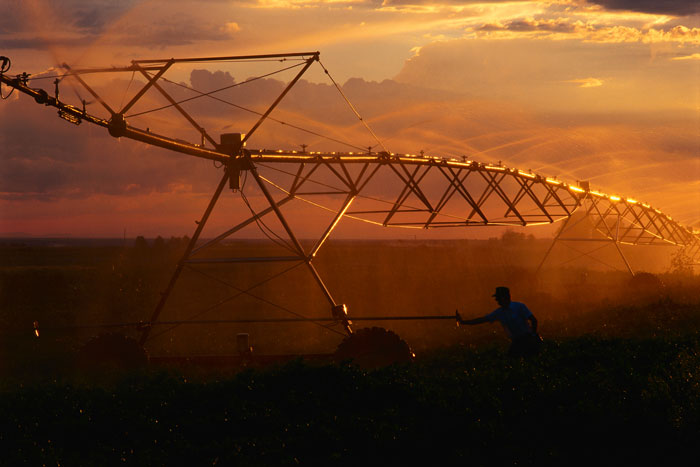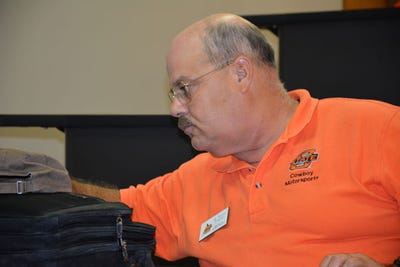
No one has to tell Oklahoma farmers that pumping irrigation water can be expensive.
In 2013, they spent some $22 million to power about 5,351 water pumps. That breaks down to a per- acre cost of $52 for ground water and $17 for surface water, says Scott Frazier, associate professor in renewable energy at Oklahoma State University.
Frazier offered some suggestions for managing those costs during the recent Oklahoma Irrigation Conference in Fort Cobb.
Most Oklahoma farmers use electric power for irrigation, 46 percent, with natural gas second at 42 percent. Only 11 percent use diesel and less than 1 percent opt for propane, butenol, ethanol etc.
Frazier says producers can lower costs by improving the efficiency of the engines, the pump system, the water distribution system and by using the most efficient management and operation systems available.
He also pointed out the advantages and the shortcomings of various pump and energy sources.
Electric pumps, for instance “are usually the cheapest to buy and the cheapest to run (That may vary from place to place and season to season.) But these systems may not be large enough for deep wells. They need three-phase power.”
Electric motors are very efficient, Frazier says, more than 90 percent. But electricity costs more than natural gas per BTU.
He recommends users learn and understand the electric rate schedule and watch for demand ratchet charges.
“Also, try to get a rate schedule that does not charge excessively during off months (the ratchet charge). High kilowatt demand charges can push the actual annual cost of electric motor irrigation closer to some fuels.”
Internal combustion engines may be more adaptable to deeper wells, Frazier says. These engines are more powerful for their size. Since irrigation systems often are located in remote locations, diesel, natural gas and propane engines may be a better choice than electric in some situations. “They do not need utility lines unless the producer is using piped natural gas.”
Frazier says these engines are expensive. Fuel is also expensive and costs vary. “Propane is the most expensive fuel option.” Fuel has to be transported to the site and engines need periodic maintenance.
“Producers also must be aware of potential for fuel or oil spills,” he says.
Diesel and fuel internal combustion engines are not very efficient, less than 30 percent but the fuel cost is less than electricity.

Scott Frazier, associate professor in renewable energy at Oklahoma State University, prepares for his presentation on pumping efficiency at the recent Oklahoma Irrigation conference in Fort Cobb.
Frazier says the internal combustion units “tend to be much more susceptible to maintenance neglect and age issues than electric motors. Producers must do regular maintenance and servicing, as one would do with a tractor or a truck.”
He says engine efficiency can drop rapidly by 10 percent to 20 percent or more because of poor maintenance. “That would show up as a direct 10 percent to 20 percent increase in annual costs.
Running engines at incorrect higher RPM than recommended specifications, Frazier says, will shorten the life of the engine and drive up fuel use.
For the latest on southwest agriculture, please check out Southwest Farm Press Daily and receive the latest news right to your inbox.
Other irrigation pumping system issues also affect efficiency. Frazier says a pipeline “valved-back” at the well so it will meet pressure requirements will cause problems. A well screen plugged by mineral incrustation and/or iron bacteria may result in extra pumping lift. A worn pump impeller may result from pumping sand or extended use. Other issues include improper impeller adjustment; altered irrigation application system without a redesign of the pumping plant; and mismatched system components such as a power unit too large or too small or an improperly-sized discharge column.
Frazier says field tests indicate irrigation pumping plant efficiency often falls short of optimum. Recommended as acceptable for an electric pump, for instance, is 65 percent. Field tests averaged from 45 percent to 55 percent. Diesel recommended as acceptable is 18 percent but field average ranges from 13 percent to 15 percent. Natural gas fares no better, acceptable range is 15 percent to 18 percent and tests show 9 percent to 13 percent. Butane or propane acceptable level is 15 percent to 18 percent with tested in the field range at 9 percent to 13 percent. Gasoline acceptable rating is 14 percent to 16 percent and tested in the field shows 9 percent to 12 percent.
Frazier says pumping water for irrigation can be expensive, regardless of the system, but with proper pump selection, application management and timely maintenance, producers can reduce the annual costs.
About the Author(s)
You May Also Like






